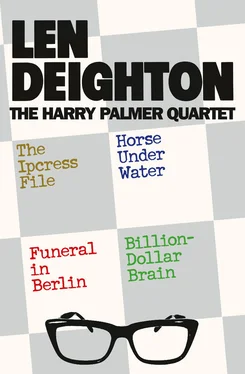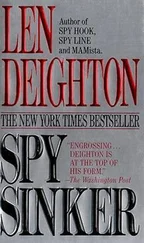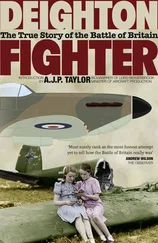About the Publisher Конец ознакомительного фрагмента. Текст предоставлен ООО «ЛитРес». Прочитайте эту книгу целиком, купив полную легальную версию на ЛитРес. Безопасно оплатить книгу можно банковской картой Visa, MasterCard, Maestro, со счета мобильного телефона, с платежного терминала, в салоне МТС или Связной, через PayPal, WebMoney, Яндекс.Деньги, QIWI Кошелек, бонусными картами или другим удобным Вам способом.
The great challenge I faced when asked to produce the covers for new editions of Len Deighton’s books was the existence of the brilliant designs conceived by Ray Hawkey for the original editions.
However, having arrived at a concept, part of the joy I derived in approaching this challenge was the quest to locate the various props which the author had so beautifully detailed in his texts. Deighton has likened a spy story to a game of chess, which led me to transpose the pieces on a chess board with some of the relevant objects specified in each book. I carried this notion throughout the entire quartet of books.
Since smoking was so much part of our culture during the Cold War era, I also set about gathering tobacco-related paraphernalia.
Each chapter of The Ipcress File opens with its Gauloises-smoking protagonist’s horoscope, so discovering an Aquarius cigarette lighter was a great coup. Finding a Gauloises cigarette packet, designed by Marcel Jacno in 1936, became a more difficult proposition. However, after much searching, I eventually found one via the Internet!
Serendipity sometimes plays an important part in the design process. In seeking an appropriate ashtray, to carry through the ‘smoking’ theme, I accidentally came across a unique piece shaped like a hand gun, so I aimed it at a red chess pawn, which represents Ipcress’s ‘Red’ Cold War antagonist.
The image of the gun pays homage to the original Hawkey-designed Ipcress jacket. I further retained the wooden type font logotype originated by him.
One of my long-time hobbies has been collecting cigarette cards. I was fortunate to find some appropriate images among my personal trove to illustrate the back cover, and these are accompanied by examples of military insignia gathered during my National Service days served in Cold War Korea!
Len Deighton and I shared a great affection for London’s Savoy Hotel. My father had served as a waiter there in the 1930s so I have a number of pieces of memorabilia from the Savoy, including the saucer and the cloakroom ticket depicted on the cover.
I was thrilled to locate the ‘Made in GDR’ syringe in Latvia, of all places. Closer to home, I have kept all my past British passports, together with most of my boarding passes and baggage labels. The Chubb key and the CND badge—which today has become a fashion accessory—came from other locations around the UK. The 1960s postage stamp on the spine of the cover commemorates the former Soviet spy, Richard Sorge.
During the 1970s, while designing a supplement series for the London Sunday Times , I needed a set of fingerprints to illustrate a specific article, so I persuaded the duty sergeant at my local police station to take mine, which are here given a new public airing!
I photographed the cover set-up using natural daylight, with my Canon OS 5D digital camera.
Arnold Schwartzman OBE RDI
LEN DEIGHTON
The Ipcress File

And now I will unclasp a secret book, And to your quick-conceiving discontents, I’ll read you matter deep and dangerous.
Henry IV
Though it must be said that every species of birds has a manner peculiar to itself, yet there is somewhat in most genera at least that at first sight discriminates them, and enables a judicious observer to pronounce upon them with some certainty.
Gilbert White, 1778
Cover
Cover Designer’s Note
Title Page
Epigraph
Introduction
Prologue
Chapter 1
Chapter 2
Chapter 3
Chapter 4
Chapter 5
Chapter 6
Chapter 7
Chapter 8
Chapter 9
Chapter 10
Chapter 11
Chapter 12
Chapter 13
Chapter 14
Chapter 15
Chapter 16
Chapter 17
Chapter 18
Chapter 19
Chapter 20
Chapter 21
Chapter 22
Chapter 23
Chapter 24
Chapter 25
Chapter 26
Chapter 27
Chapter 28
Chapter 29
Chapter 30
Chapter 31
Chapter 32
Epilogue
Appendix
The Ipcress File was my first attempt to write a book. I was a commercial artist, or ‘illustrator’ as we are now called. I had never been a journalist or reporter of any kind so I was unaware of how long writing a book was likely to take. Knowing the size of the task is a deterrent for many professional writers, which is why they defer their ambitions often until it is too late. Being unaware of what’s ahead can be an advantage. It shines a green light for everything from enlisting in the Foreign Legion to getting married.
So I stumbled into writing this book with a happy optimism that ignorance provides. Was it a depiction of myself? Well, who else did I have? After completing two and a half years of military service I had been, for three years, a student at St. Martin’s School of Art in Charing Cross Road. I am a Londoner. I grew up in Marylebone and once art school started I rented a tiny grubby room around the corner from the art school. This cut my travelling time back to five minutes. I grew to know Soho very well indeed. I knew it by day and by night. I was on hello , how are you? terms with the ‘ladies’, the restaurateurs, the gangsters and the bent coppers. When, after some years as an illustrator, I wrote The Ipcress File much of its description of Soho was the observed life of an art student resident there.
After three years postgraduate study at the Royal College of Art I celebrated by impulsively applying for a job as flight attendant with British Overseas Airways. In those days this provided three or four days stop-over at the end of each short leg. I spent enough time in Hong Kong, Cairo, Nairobi, Beirut and Tokyo to make good and lasting friendships there. When I became an author, these background experiences of foreign people and places proved of lasting benefit.
I don’t know why or how I came to writing books. I had always been a dedicated reader; obsessional is perhaps the better word. At school, having proved to be a total dud at any form of sport – and most other things – I read every book in sight. There was no system to my reading, nor even a pattern of selection. I remember reading Plato’s The Republic with the same keen attention and superficial understanding as I read Chandler’s The Big Sleep and H.G. Wells’ The Outline of History and both volumes of The Letters of Gertrude Bell . I filled notebooks as I encountered ideas and opinions that were new to me, and I vividly remember how excited I was to discover that The Oxford Universal Dictionary incorporated thousands of quotations from the greatest of great writers.
Читать дальше













